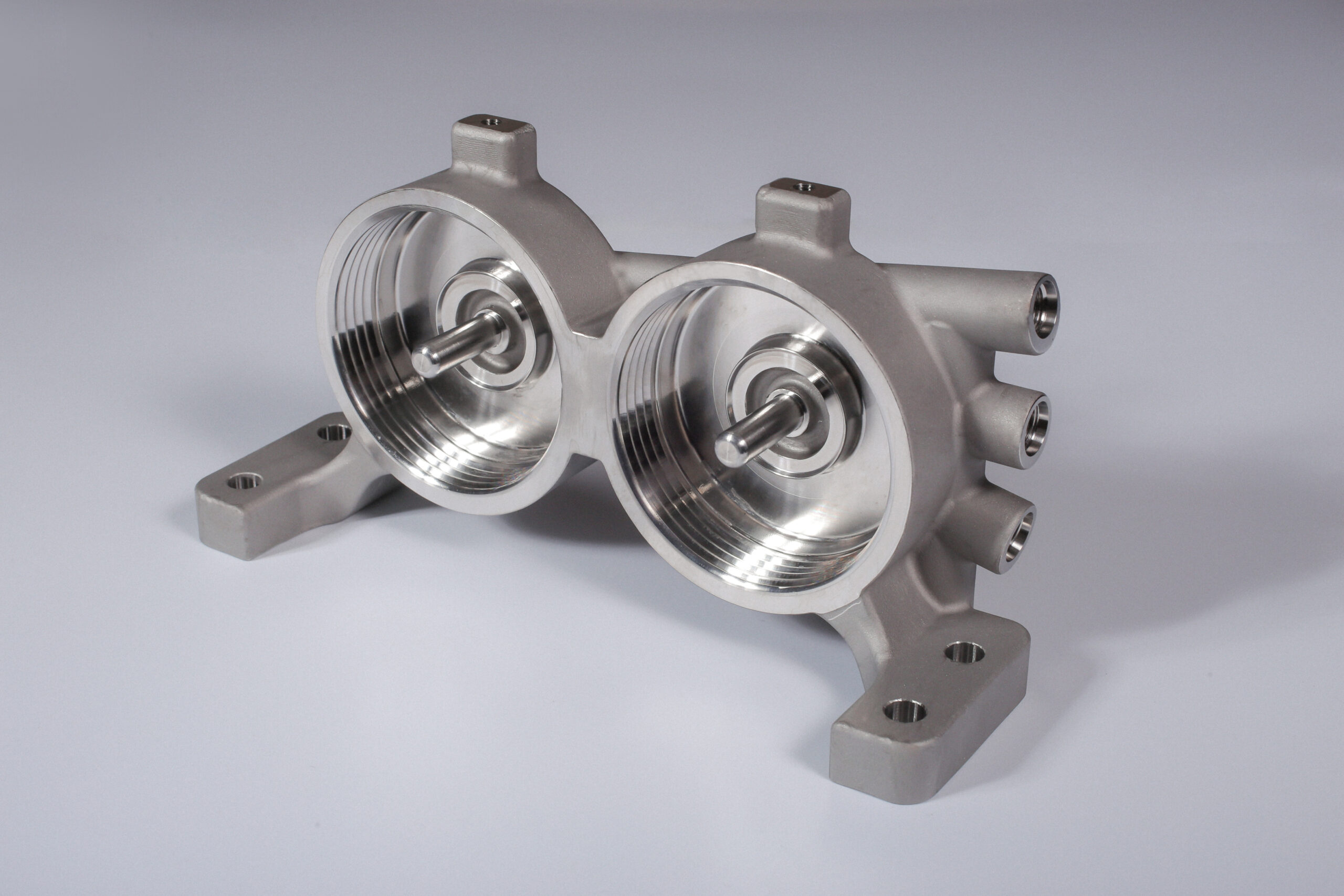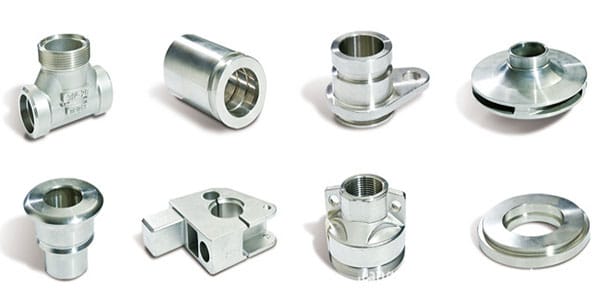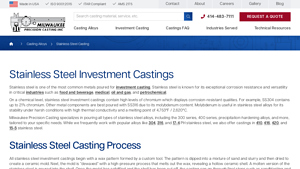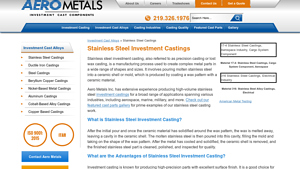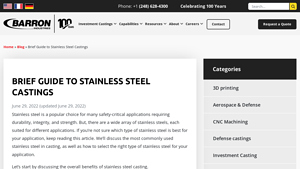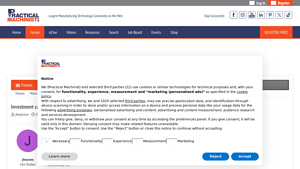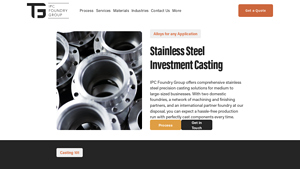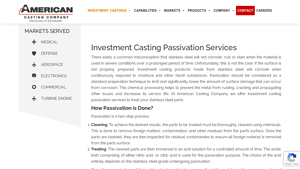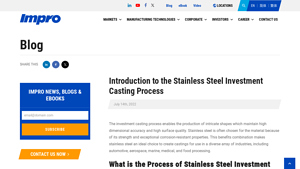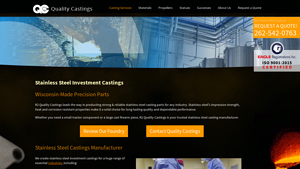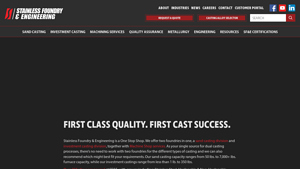Investment Casting Stainless Steel Guide: Type, Cost, Top List…
Introduction: Navigating the Global Market for investment casting stainless steel
In the complex landscape of global manufacturing, sourcing high-quality investment casting stainless steel can pose significant challenges for international B2B buyers. Industries across Africa, South America, the Middle East, and Europe, including key markets such as Nigeria and Germany, grapple with the need for materials that are durable, corrosion-resistant, and suited for precise applications. This guide offers a deep dive into the world of stainless steel investment casting, addressing critical elements such as types of alloys, various applications, supplier vetting strategies, and cost considerations.
Throughout this comprehensive resource, buyers will gain insights into the unique properties of different stainless steel grades, such as 304, 316, and 17-4 PH, and their optimal use in sectors ranging from aerospace to petrochemical. Understanding the intricacies of the investment casting process—from wax pattern creation to the final inspection phase—will empower businesses to make informed decisions that enhance their production capabilities.
In addition to detailing important technical specifications, this guide also focuses on strategic supplier selection and the importance of certifications like ISO and ITAR, ensuring that buyers align with reputable partners. By leveraging the insights provided, B2B professionals will navigate the complexities of the stainless steel market efficiently, driving value and success in their procurement efforts.
Understanding investment casting stainless steel Types and Variations
| Type Name | Key Distinguishing Features | Primary B2B Applications | Brief Pros & Cons for Buyers |
|---|---|---|---|
| Austenitic Stainless Steel (e.g., 304, 316) | Excellent corrosion resistance; high ductility | Food processing, marine, oil & gas | Pros: Ease of fabrication, high aesthetic value. Cons: Lower hardness compared to martensitic types. |
| Ferritic Stainless Steel (e.g., 430) | Good corrosion resistance; less ductile, magnetic | Automotive, household appliances | Pros: Cost-effective, good oxidizing environment tolerance. Cons: Not as strong as austenitic grades. |
| Martensitic Stainless Steel (e.g., 410, 420) | High hardness and strength; less corrosion resistant | Aerospace, military, oil & gas components | Pros: Suitable for high-stress applications. Cons: Vulnerable to corrosion compared to austenitic steels. |
| Precipitation-Hardening Stainless Steel (e.g., 17-4 PH) | High strength; aging process enhances properties | Aerospace, medical devices | Pros: Very strong and corrosion-resistant. Cons: More complex processing requirements. |
| Duplex Stainless Steel (e.g., 2205) | Combination of austenitic and ferritic properties | Offshore oil & gas, chemical industries | Pros: Excellent resistance to stress corrosion. Cons: Requires careful welding practices. |
What is Austenitic Stainless Steel and Why Should B2B Buyers Consider it?
Austenitic stainless steels, like 304 and 316, are renowned for their superior corrosion resistance and overall versatility. Their high ductility and formability make them ideal for applications in industries such as food processing and marine environments. Buyers should consider the specific applications and environments their products will face, as these grades excel in both aesthetic and functional aspects, making them suitable for parts requiring hygiene and appearance.
How Does Ferritic Stainless Steel Benefit Various Industries?
Ferritic stainless steels, such as grade 430, provide decent corrosion resistance while also being magnetic. They are particularly cost-effective for applications in the automotive sector and kitchen appliances where corrosion resistance is needed, but extreme strength is not a priority. B2B buyers should evaluate their cost-effectiveness versus performance requirements, especially in non-critical applications, where ferritic options can significantly reduce costs.
Why Choose Martensitic Stainless Steel for Heavy-Duty Applications?
Martensitic stainless steels, exemplified by grades like 410 and 420, are characterized by their high strength and hardness, making them suitable for demanding environments such as aerospace and military applications. However, their lower corrosion resistance compared to austenitic steels is a significant consideration. Buyers targeting applications that require high wear resistance must balance the need for strength with potential corrosion risks, often opting for coatings or surface treatments to enhance longevity.
What Advantages Do Precipitation-Hardening Alloys Offer?
Precipitation-hardening stainless steels, such as 17-4 PH, provide exceptional strength and corrosion resistance, making them particularly valuable in the aerospace and medical sectors. Their mechanical properties can be enhanced through an aging process, which may involve additional processing costs. B2B buyers should be knowledgeable about the detailed engineering requirements for such materials to ensure compatibility with their intended applications.
Why is Duplex Stainless Steel Ideal for Challenging Environments?
Duplex stainless steels, like 2205, combine properties of both ferritic and austenitic steels, resulting in excellent corrosion resistance, particularly against stress corrosion cracking. This grade is favored in offshore oil and gas settings and chemical processing plants. Buyers should take into account the specific environmental conditions, as well as the need for skilled welding techniques, to maximize the durability and performance of duplex materials in high-stress situations.
Key Industrial Applications of investment casting stainless steel
| Industry/Sector | Specific Application of investment casting stainless steel | Value/Benefit for the Business | Key Sourcing Considerations for this Application |
|---|---|---|---|
| Aerospace | Aircraft components like brackets and housings | High strength-to-weight ratio, precision manufacturing | Required certifications (ISO, FAA), tight tolerances, weight limits |
| Oil & Gas | Equipment for drilling and extraction | Exceptional corrosion resistance under harsh conditions | Assess quality of corrosion resistance, lead times for delivery |
| Medical | Surgical instruments and implants | Biocompatibility and high hygiene standards | Certifications (FDA, ISO 13485), specific alloy requirements |
| Food & Beverage | Processing and storage tanks | Hygienic properties and resistance to food acids | Regulatory compliance (FDA), ease of cleaning and maintenance |
| Automotive | Engine parts and transmission components | Durability and performance under mechanical stress | Material specifications, cost efficiency, supplier reliability |
How is Investment Casting Stainless Steel Utilized in Aerospace Applications?
In the aerospace industry, stainless steel investment casting is vital for producing components such as brackets and housings that demand high strength with minimal weight. The process allows for intricate designs that are essential for ensuring precise fit and function in aircraft assemblies. Buyers in this field should pay attention to required certifications like ISO and FAA, as well as the importance of achieving tight tolerances, which facilitate the reliable performance of critical aerospace components.
What Benefits Does Investment Casting Stainless Steel Provide for the Oil & Gas Sector?
For the oil and gas industry, investment casting stainless steel is critical in creating robust equipment for drilling and extraction. The stainless steel’s exceptional corrosion resistance is key to withstanding the tough environmental conditions typically faced in this sector. International buyers should prioritize sourcing from suppliers who can demonstrate quality assurance in corrosion resistance testing, as well as the ability to meet stringent lead times crucial for project timelines.
Why is Investment Casting Stainless Steel Crucial for Medical Applications?
Investment casting stainless steel is extensively used for surgical instruments and implants, where biocompatibility and stringent hygiene standards are non-negotiable. The precision casting process allows manufacturers to create complex shapes that enhance functionality in medical applications. Buyers from the medical sector should verify certifications such as FDA and ISO 13485 to ensure compliance with regulatory requirements, while also considering the specific alloy composition required for their applications.
How Does Investment Casting Stainless Steel Enhance Food & Beverage Processing?
In the food and beverage sector, stainless steel investment casting is essential for manufacturing processing and storage tanks that must adhere to strict hygiene standards. The inherent properties of stainless steel, including its resistance to food acids and ease of cleaning, provide significant benefits for maintaining food safety. Importantly, buyers should consider regulatory compliance (like FDA standards) and the design’s ease of maintenance to ensure longevity and performance in food processing environments.
What Advantages Does Investment Casting Stainless Steel Offer in Automotive Manufacturing?
Stainless steel plays a pivotal role in the automotive industry, particularly for components like engine parts and transmission assemblies. The durability and ability to withstand high mechanical stress make stainless steel investment casting an excellent choice. International B2B buyers should focus on material specifications to ensure high performance, along with cost-efficiency and the reliability of suppliers to meet their production schedules and quality standards.
3 Common User Pain Points for ‘investment casting stainless steel’ & Their Solutions
Scenario 1: Navigating Corrosion Resistance Standards in Different Markets
The Problem: B2B buyers often struggle with ensuring that their stainless steel investment castings meet the specific corrosion resistance standards required in their industry and location. This is particularly relevant when dealing with international markets, where standards can vary dramatically. For example, a buyer in the food and beverage sector may need to satisfy stricter regulations in Europe compared to those in South America. This lack of uniformity can lead to the selection of inappropriate materials, resulting in costly recalls, damage claims, or product failures.
The Solution: To navigate these diverse corrosion resistance requirements, buyers should take the time to consult local standards and specifications relevant to their sector. Engage with quality assurance professionals and your investment casting supplier to ensure clarity on the desired alloy—like SS316 for marine applications or SS304 for food environments. When placing orders, specify both the desired certification and finish based on these standards. Suppliers should provide documentation proving compliance with international standards such as ISO 9001 or industry-specific certifications. This proactive approach not only helps in achieving regulatory compliance but also enhances trust with customers by ensuring product integrity.
Scenario 2: Managing Lead Times and Production Delays
The Problem: Many international B2B buyers encounter significant challenges with lead times when sourcing stainless steel investment castings. Delays can arise from various factors, including supplier capacity, shipping logistics, and fluctuating raw material availability. For critical projects, such as those in the aerospace or medical sectors, these delays can halt production lines, leading to missed deadlines and financial losses.
The Solution: Proactively managing lead times begins with transparent communication from the onset. Establish a robust relationship with casting suppliers by clearly conveying your project timelines and potential penalties for delays. Utilize technology, such as project management software, to track production stages and communicate changes in real-time. Consider building a safety stock of critical components to buffer against unforeseen delays. Additionally, source from manufacturers with a proven track record of on-time delivery and the capability to meet your production needs flexibly. This can often be confirmed through testimonials or case studies provided by the supplier.
Scenario 3: Ensuring Precision and Tolerances in Complex Designs
The Problem: B2B buyers frequently face issues achieving the exacting tolerances required for complex designs when investing in stainless steel castings. A mistake in measurement or details overlooked in the design phase can lead to parts that do not fit correctly, impacting assembly lines, increasing waste, and prolonging project timelines.
The Solution: To avoid pitfalls related to precision, start the process with thorough design reviews. Collaborate closely with suppliers during the design phase to utilize their expertise in material properties and manufacturing capabilities. Detailed specifications, including tolerances, should be clearly outlined during design discussions; use CAD models to facilitate clear communication. Additionally, consider utilizing prototyping services that many casting manufacturers offer. By creating an initial prototype, you can assess fit and performance before moving to full production, thereby ensuring your final product meets tight tolerances and design requirements. Regular quality checks and inspections during the castings process will further reduce the risk of errors, ensuring the final output meets industry standards.
Strategic Material Selection Guide for investment casting stainless steel
What are the Key Properties and Applications of Common Stainless Steel Materials for Investment Casting?
Investment casting stainless steel encompasses several alloys, each with distinct properties and performance characteristics that cater to different applications across various industries. Below is a detailed analysis of three commonly used stainless steel alloys in investment casting.
Analysis of Common Alloys for Investment Casting
1. Stainless Steel 304
304 stainless steel is one of the most versatile materials used in investment casting. It contains approximately 18% chromium and 8% nickel, contributing to its excellent corrosion resistance and formability.
- Key Properties: This material performs well in environments with moderate corrosive elements and temperatures up to 870°F (465°C).
- Pros: Offers excellent hygiene, high strength-to-weight ratio, and good weldability, making it suitable for food and medical applications.
- Cons: It is not as corrosion-resistant in chloride environments compared to other grades, which might lead to stress corrosion cracking.
- Impact on Application: Frequently used in the food processing and medical fields, the compatibility with various cleaning agents ensures the maintainability of hygiene standards.
- Considerations for Buyers: Buyers particularly in Europe, where standards like ASTM A240/A240M and DIN 1.4301 are prevalent, should ensure compliance with these regulations for seamless trade and operation.
2. Stainless Steel 316
Stainless Steel 316 is known for its enhanced corrosion resistance, especially against chlorides and other harsh chemicals, thanks to the inclusion of molybdenum (2-3%).
- Key Properties: Its operational limits extend up to 925°F (496°C), making it ideal for applications involving elevated temperatures and corrosive environments.
- Pros: Operates effectively in seawater environments and is preferred for marine applications; it provides exceptional weldability and ductility.
- Cons: Less cost-effective than 304 due to higher alloy content, which may impact the overall project budget.
- Impact on Application: Critical in industries such as marine and petrochemical, where resistance to corrosion from salts and organic substances is crucial.
- Considerations for Buyers: B2B buyers in regions like the Middle East, where marine applications are important, should prioritize supplier compliance with international standards like ASTM A276 for stainless steel products.
3. Stainless Steel 17-4 PH
17-4 PH is a precipitation-hardening stainless steel, offering high strength and excellent corrosion resistance through heat treatment.
- Key Properties: Suitable for temperatures up to 600°F (316°C) and offers exceptional strength, making it appropriate for demanding applications.
- Pros: Ideal for aerospace and military applications where high strength-to-weight ratios are essential; can be heat-treated for customized mechanical properties.
- Cons: Requires careful heat treatment processes, which increases manufacturing complexity and costs.
- Impact on Application: Commonly used in aerospace components, fasteners, and valve parts where reliability and precision are paramount.
- Considerations for Buyers: Particularly in Africa and South America, understanding local regulations regarding aerospace and military standards will be vital for compliance and effective sourcing.
Summary Table of Common Stainless Steel Materials for Investment Casting
| Material | Typical Use Case for investment casting stainless steel | Key Advantage | Key Disadvantage/Limitation | Relative Cost (Low/Med/High) |
|---|---|---|---|---|
| 304 | Food processing, medical equipment | Excellent corrosion resistance | Susceptible to chlorides | Medium |
| 316 | Marine, petrochemical applications | Superior chloride resistance | Higher cost than 304 | High |
| 17-4 PH | Aerospace components, high-stress applications | Exceptional strength, heat-treatable | Manufacturing complexity | High |
This guide should assist international B2B buyers in making informed decisions regarding material selection for investment casting stainless steel. By understanding the properties, applications, and market considerations, buyers can align their sourcing strategies with industry requirements and standards.
In-depth Look: Manufacturing Processes and Quality Assurance for investment casting stainless steel
Investment casting of stainless steel is a complex, meticulously controlled process that ensures the production of high-quality components essential for various industries. Understanding the manufacturing processes and quality assurance (QA) practices is critical for B2B buyers, especially those engaging with international suppliers.
What Are the Key Stages in the Manufacturing Process for Investment Casting Stainless Steel?
The manufacturing process for stainless steel investment casting comprises several critical stages: material preparation, forming, assembly, and finishing.
How Is Material Prepared for Investment Casting?
The first step involves selecting the appropriate stainless steel alloy based on the desired corrosion resistance, mechanical properties, and application needs. Common alloys used in investment casting include 304, 316, and 17-4 PH. Once the alloy is chosen, the metal is melted in a furnace, typically employing induction melting techniques to ensure uniform temperature and composition.
What Techniques Are Used for Forming in Investment Casting?
The forming stage is initiated with the creation of a wax pattern that reflects the final product’s geometry. The wax is coated in a ceramic material to form a mold. Once the coating hardens, the wax is removed using a dewaxing process involving heat. This leaves a hollow ceramic shell that takes the shape of the desired component. The molten stainless steel is then poured into the shell. This process allows for intricate designs and tolerances, essential for applications in aerospace, automotive, and medical industries.
How Is the Assembly Process Conducted?
After the molten metal cools and solidifies, the ceramic shell is broken away, revealing the cast part. The assembly phase often includes multiple components, which may require further machining or alterations to meet the specific design and performance criteria. This stage is crucial for ensuring that all components fit and function together precisely, especially in safety-critical applications.
What Finishing Techniques Are Commonly Employed?
The finishing process involves cleaning, polishing, and surface treatment to meet specific aesthetic and functional requirements. Operations such as sandblasting may be performed to achieve a uniform surface finish. Additional treatments, such as heat treatment, can enhance strength and corrosion resistance.
What Quality Control Measures Are Integral to the Investment Casting Process?
Quality assurance is paramount in investment casting to ensure that the parts meet customer specifications and regulatory standards.
Which International Standards Govern Quality Control for Investment Casting?
B2B buyers must consider compliance with international quality standards such as ISO 9001, which outlines requirements for a quality management system. For industry-specific applications, certifications like CE for European markets and API for oil and gas applications might also be essential. Ensuring that suppliers hold relevant certifications can mitigate risks associated with non-compliance.
How Are Quality Checkpoints Integrated Within the Manufacturing Process?
Investment casting involves several quality checkpoints throughout the manufacture:
-
Incoming Quality Control (IQC): Raw materials, including stainless steel, undergo verification against specifications before being accepted. This process ensures that only high-quality materials are used in production.
-
In-Process Quality Control (IPQC): Throughout the casting process, various parameters (like temperature and mold integrity) are monitored. This monitoring minimizes defects and enhances overall part quality.
-
Final Quality Control (FQC): Once the cast parts are produced, they are subjected to rigorous inspection procedures. This includes dimensional checks, surface quality assessments, and mechanical testing to confirm that each part meets the established standards.
What Common Testing Methods Are Employed in Quality Assurance?
Typical testing methods include:
-
Dimensional Inspection: Tools such as calipers and gauges are utilized to ensure that parts conform to specified dimensions.
-
Non-Destructive Testing (NDT): Techniques like ultrasonic testing and X-ray inspections help identify internal faults without damaging the components.
-
Metallurgical Testing: This is essential for analyzing the material’s microstructure, ensuring it meets the required mechanical properties.
How Can B2B Buyers Verify Supplier Quality Control Practices?
For international B2B buyers, particularly those from Africa, South America, the Middle East, and Europe, establishing trust in supplier quality is essential. There are several methods to validate QC processes and certifications:
What Are Best Practices for Auditing Suppliers?
Conducting supplier audits is a proactive approach to understanding process capabilities and compliance with quality standards. Auditors should examine facilities, procedures, and documentations such as ISO certifications and quality management records. Engaging third-party inspection agencies can also provide an unbiased review of the supplier’s practices.
How Do Quality Reports and Certifications Affect Supplier Selection?
Requesting detailed quality reports can provide insight into the manufacturer’s historical performance in meeting QC standards and addressing any deviations that have occurred. Prospective buyers should evaluate these reports critically, looking for consistent quality and responsiveness to previous issues.
What Nuances Should International Buyers Consider Regarding QC Certification?
Buyers from different regions may face challenges with QC certification recognition and compatibility, as certification interpretations can vary by region. For instance, understanding the distinction between local certifications and international ones like ISO can be essential in maintaining compliance across borders.
By gaining an in-depth understanding of both the manufacturing processes and the rigorous quality control measures in stainless steel investment casting, B2B buyers can make informed decisions that ensure product quality, reliability, and compliance with international standards. This knowledge empowers buyers to establish fruitful collaborations with suppliers that meet their specific needs while navigating the complexities of global trade.
Practical Sourcing Guide: A Step-by-Step Checklist for ‘investment casting stainless steel’
To assist international B2B buyers, particularly in Africa, South America, the Middle East, and Europe, this sourcing guide provides a structured approach to procuring stainless steel investment castings. By following these steps, you can ensure a successful procurement process that meets your technical needs and quality expectations.
Step 1: Define Your Technical Specifications
Before starting your procurement process, it’s essential to outline your technical requirements. This includes understanding the specific stainless steel grade (304, 316, etc.), dimensions, tolerances, and any secondary processes needed, such as heat treatment or surface finishing. Being precise in these specifications will help you communicate effectively with potential suppliers and receive accurate quotations.
Step 2: Research Potential Suppliers
Conduct thorough research to identify manufacturers with a solid reputation in stainless steel investment casting. Look for suppliers with certifications such as ISO 9001, which indicates adherence to quality management standards. Additionally, investigate their experience in your specific industry—whether it’s aerospace, medical, or automotive—as industry-specific expertise can significantly influence the quality and reliability of the cast parts.
Step 3: Verify Supplier Certifications
Quality assurance is paramount in investment casting, so verifying supplier certifications is a critical step. Check for certifications relevant to manufacturing processes and industry standards, such as ITAR for defense-related projects or FDA compliance for medical applications. Such certifications assure you of the supplier’s commitment to maintaining high standards and mitigating risks associated with product quality.
Step 4: Request Samples or Prototypes
Before committing to a full order, request samples or prototypes of the casting. This allows you to assess the surface finish, precision, and overall quality of the steel castings yourself. Additionally, reviewing a prototype helps identify any design flaws early in the process, which can save time and costs in subsequent production stages.
Step 5: Evaluate Production Capabilities
Ensure the chosen supplier has the production capabilities to meet your project’s timeline and volume requirements. Discuss their lead times and how they handle orders of varying sizes, from small batches to large runs. It’s also crucial to understand their capacity for scaling production if your needs increase in the future.
Step 6: Understand the Pricing Structure
Clarify the pricing structure with your potential suppliers, as hidden costs can often arise in manufacturing. Ask for a detailed breakdown of quotations, including costs related to tooling, materials, and any additional processes like machining or finishing. Comparing quotes based on the same specifications will allow for a more direct evaluation and helps in budgeting effectively.
Step 7: Negotiate Terms of Agreement
Once you’ve selected a supplier based on these evaluations, move toward establishing a contractual agreement. Pay attention to terms related to warranty, service level agreements (SLAs), delivery schedules, and penalties related to delays or quality issues. Having clear terms can protect your interests and foster a trustworthy relationship with the supplier, ensuring smoother future transactions.
By meticulously following this checklist, B2B buyers will be well-positioned to select a supplier for stainless steel investment casting that meets their specific needs, ensuring quality, reliability, and value in each component procured.
Comprehensive Cost and Pricing Analysis for investment casting stainless steel Sourcing
Investment casting stainless steel has become a popular choice for manufacturers globally due to its versatility, durability, and excellent aesthetic qualities. Understanding the cost structure and pricing factors is crucial for B2B buyers, especially those operating from regions such as Africa, South America, the Middle East, and Europe.
What Are the Key Cost Components in Stainless Steel Investment Casting?
The total cost of stainless steel investment casting can be broken down into several key components:
-
Materials: The primary cost driver in any investment casting process, materials account for a significant portion of overall expenses. Stainless steel, particularly high-quality alloys like 304, 316, and 17-4 PH, incurs varying costs based on market fluctuations and demand. Nickel content, for instance, can greatly impact prices.
-
Labor: Skilled labor is necessary to manage the intricacies of the investment casting process, from creating wax patterns to quality assurance. Labor costs will vary based on geographical location and labor laws, which may affect pricing structures for buyers in different regions.
-
Manufacturing Overhead: This encompasses costs related to the operation of the casting facility, including utilities, maintenance, and administrative expenses. Buyers should evaluate suppliers’ operational efficiencies, as these can directly influence pricing.
-
Tooling: Initial tooling costs can be substantial, particularly for custom designs. Investment required for molds and pattern development can be recouped with higher volume orders, making MOQ (Minimum Order Quantity) negotiations vital for reducing overall costs in the long term.
-
Quality Control: Rigorous quality checks are essential to ensure compliance with industry standards. The cost of QC should be transparently communicated by suppliers, as it might include inspections, testing, and certifications that may directly impact pricing.
-
Logistics: Shipping costs can vary significantly based on the supplier’s location in relation to the buyer. Factors like shipping method, freight rates, and any associated customs duties must be factored into the overall pricing.
-
Margin: Suppliers will include a profit margin within their pricing. This varies depending on their competitive positioning in the market and the perceived value of their products and services.
What Influences the Pricing of Stainless Steel Investment Castings?
Several elements can influence the pricing of stainless steel investment castings:
-
Volume and MOQ: Higher volumes often lead to lower per-unit costs. B2B buyers looking to reduce costs should negotiate for favorable terms that maximize the number of units per order.
-
Specifications and Customization: Custom-designed parts with unique specifications may incur higher costs due to additional tooling and quality assurance requirements. Buyers should weigh the necessity of customization against cost considerations.
-
Materials and Quality Certifications: The selection of raw materials can significantly influence pricing. Certifications and compliance with local or international standards can also add to the final cost, especially in markets with strict regulatory protocols.
-
Supplier Factors: Different suppliers have varying production capabilities, quality standards, and reputational histories. Sellers positioned as industry leaders may command higher prices but offer better reliability and efficiency, which could result in cost savings long-term.
-
Incoterms: The choice of International Commercial Terms (Incoterms) can affect pricing markedly. Buyers should choose incoterms that align with their logistics strategies to avoid unexpected costs down the line.
What Are the Best Practices for Buyers to Optimize Investment Casting Costs?
-
Negotiation Strategies: Build relationships with multiple suppliers to leverage competitive quotes. Clear communication about your needs can lead to better pricing arrangements.
-
Total Cost of Ownership: Consider long-term costs rather than just upfront pricing. High-quality parts may carry a premium but can offer enhanced durability and reduced maintenance costs over time.
-
Pricing Nuances for International Buyers: Understand currency fluctuations, shipping challenges, and regional regulations that can impact costs. Familiarizing oneself with local tariffs and duties is crucial for budgeting.
-
Seek Transparency: Always request itemized quotes before making purchasing decisions. Clear breakdowns will help identify areas to negotiate or seek alternatives.
-
Utilize a Global Network of Suppliers: Connecting with suppliers across various regions can foster competitive pricing. This is especially beneficial for industries reliant on specific alloys or intricate designs, as innovation cycles can vary by market.
In summary, navigating the cost structure of stainless steel investment casting involves understanding multiple components and influences. For B2B buyers, strategically managing these factors can lead to significant savings and improved product outcomes. The painting of the picture of opportunities and challenges can help create a successful sourcing strategy.
Alternatives Analysis: Comparing investment casting stainless steel With Other Solutions
Exploring Alternatives to Investment Casting Stainless Steel
Investment casting stainless steel is widely recognized for its precision and versatility, but it’s essential to evaluate alternative solutions that can meet your needs in different contexts. This analysis focuses on two viable alternatives—die casting aluminum and metal injection molding (MIM)—to help B2B buyers make an informed decision.
| Comparison Aspect | Investment Casting Stainless Steel | Die Casting Aluminum | Metal Injection Molding (MIM) |
|---|---|---|---|
| Performance | High precision, excellent surface finish, and superior corrosion resistance. | Good dimensional accuracy, less durable against corrosion compared to stainless steel. | Exceptional precision; smooth surfaces; complex geometries possible. |
| Cost | Higher upfront costs due to detailed processes and material. | Generally lower costs due to high volume production capabilities. | Moderate costs can be offset by high production runs. |
| Ease of Implementation | Requires specialized skills and equipment for wax patterns and molds. | Quicker setup with standardized equipment; easier to scale. | Requires designing molds and tooling, but rapid production once established. |
| Maintenance | Durable and requires low maintenance in most environments. | Less durable in harsh conditions; coatings often needed. | Very low maintenance once in use due to part durability. |
| Best Use Case | Ideal for applications requiring complex components and high strength, such as aerospace, oil & gas, and medical. | Suitable for high-volume production of simpler parts in automotive and consumer goods. | Best for small, complex parts in industries like electronics and automotive. |
Analyzing Die Casting Aluminum as an Alternative
Die casting aluminum involves forcing molten aluminum into a mold under pressure, which allows for rapid production and efficient reuse of materials. This method is particularly beneficial for larger runs of simpler components where stringent tolerances are required. The primary advantage lies in its lower cost and faster production time compared to stainless steel investment casting. However, aluminum’s susceptibility to corrosion limits its applicability in many industrial contexts, particularly in harsh environments.
Evaluating Metal Injection Molding (MIM)
Metal injection molding (MIM) combines fine metal powders with polymers to create intricate parts. This method excels in producing small components with complex geometries and high precision, making it appropriate for industries requiring delicate and detailed designs, such as electronics and medical devices. MIM offers a good balance of cost and performance, particularly in high-volume settings. Nevertheless, the initial tooling investment can be significant, and MIM is generally not suitable for large parts, limiting its utility in broader applications compared to investment casting.
Making the Right Choice for Your Manufacturing Needs
When selecting the most suitable manufacturing process, B2B buyers should carefully assess their specific project requirements. Consider factors such as part complexity, corrosion resistance, production volume, and budget constraints. Investment casting stainless steel is unparalleled for high-strength, corrosion-resistant applications, especially in critical industries. However, for high-volume production of less complex parts, die casting aluminum may prove more cost-effective, while MIM can offer exceptional precision for intricate designs in smaller runs. By aligning your choice with your unique operational demands, you can ensure optimal performance and cost-efficiency in your manufacturing processes.
Essential Technical Properties and Trade Terminology for investment casting stainless steel
What Are the Key Technical Properties of Investment Casting Stainless Steel?
Investment casting stainless steel is recognized for its remarkable properties that cater specifically to various industrial applications. Understanding these properties is essential for B2B buyers to make informed decisions regarding material selection and product specifications.
1. Material Grade
The grade of stainless steel, such as 304, 316, or 17-4, is critical because it directly impacts corrosion resistance, strength, and heat resilience. For instance, 316 stainless steel possesses enhanced resistance to chlorides, making it suitable for marine environments. Selecting the appropriate grade helps ensure that the casting will perform well in its intended application, reducing the risk of product failure and subsequent financial losses.
2. Tolerance Levels
Tolerance levels refer to the allowable deviation from specified dimensions in a casting. Tight tolerances (often as precise as ±0.005 inches) increase the accuracy and functionality of parts, especially in sectors like aerospace and medical where precision is paramount. Understanding the required tolerances can help buyers choose manufacturers that can meet strict quality standards, ensuring fit and performance in assembly processes.
3. Heat Treatment Capability
Heat treatment processes such as annealing or hardening can enhance the mechanical properties of stainless steel castings, improving strength and wear resistance. Buyers should inquire about a manufacturer’s heat treatment capabilities, as it can dramatically affect the durability and lifespan of the cast parts, ultimately impacting operational costs over time.
4. Corrosion Resistance
Due to its chromium content, stainless steel offers exceptional corrosion resistance, which is essential for components exposed to harsh environmental conditions. For B2B buyers, understanding the corrosion resistance levels can help them evaluate the longevity and maintenance needs of their products, leading to better lifecycle cost assessments.
5. Surface Finish
The surface finish of a cast part, often specified in RMS (Root Mean Square), affects not only aesthetics but also functionality, such as abrasion resistance and ease of cleaning. A finer surface finish may be necessary for applications in the food and medical fields, where hygiene and cleanliness are critical. Specifying surface finishes helps buyers ensure their components meet industry regulations.
Which Trade Terms Are Important for B2B Buyers of Investment Casting Stainless Steel?
Navigating the world of investment casting involves familiarizing oneself with specific trade terminology that can affect transactional decisions.
1. OEM (Original Equipment Manufacturer)
An OEM is a company that produces parts or equipment typically used in another company’s end product. Understanding the role of OEMs in the supply chain helps buyers identify potential partnerships and ensure that their requirements match the capabilities of the manufacturers.
2. MOQ (Minimum Order Quantity)
MOQ refers to the smallest quantity of items a supplier is willing to sell. Knowing the MOQ is crucial for companies, particularly startups or those with fluctuating demand, as it can constrain purchasing flexibility or impact inventory management.
3. RFQ (Request for Quotation)
An RFQ is a document used to solicit price quotes from suppliers. This process is vital for buyers looking to compare costs, terms, and lead times from multiple manufacturers. An effectively crafted RFQ streamlines procurement and fosters competitive pricing.
4. Incoterms (International Commercial Terms)
Incoterms define the responsibilities of buyers and sellers regarding shipping, insurance, and tariffs. Understanding these terms is essential for international trade, as they help mitigate risks and clarify financial responsibilities in cross-border transactions.
5. BOM (Bill of Materials)
A BOM is a comprehensive list detailing all parts, sub-assemblies, and raw materials needed to manufacture a product. This document is critical for B2B procurement, as it aids in accurate cost estimations and inventory management.
By grasping both the technical specifications and relevant trade terminologies associated with investment casting stainless steel, B2B buyers can navigate the procurement landscape more effectively, ensuring they make choices aligned with their operational needs.
Navigating Market Dynamics and Sourcing Trends in the investment casting stainless steel Sector
What Are the Key Trends Driving the Investment Casting Stainless Steel Market?
The investment casting stainless steel market is currently experiencing significant growth due to a confluence of global factors. As industries such as aerospace, automotive, and energy seek to enhance their product offerings with high-precision parts, the demand for stainless steel castings has surged, particularly for grades known for their corrosion resistance, such as 304 and 316. International B2B buyers in regions like Africa, South America, the Middle East, and Europe are now prioritizing suppliers that not only deliver high-quality products but also provide efficiency in lead times and adaptability in design.
Emerging technologies, including advancements in 3D printing and digital twin technology, are reshaping the landscape by reducing costs and improving the speed of design and prototyping. Such innovations enable manufacturers to create complex parts with improved accuracy, thus attracting buyers focused on precision in demanding applications, such as medical devices and food processing equipment. Furthermore, the trend toward automation in manufacturing processes is compelling many companies to invest in casting technologies that ensure consistent quality and minimize waste.
Global supply chain dynamics are also influencing the sourcing landscape. Recent disruptions prompted by geopolitical tension and the COVID-19 pandemic have led B2B buyers to diversify their supplier databases and establish relationships with local providers to mitigate risks. Countries in Africa and South America, for instance, are enhancing their manufacturing capabilities, increasingly positioning themselves as viable sourcing alternatives in a competitive global market.
How Is Sustainability Influencing the Investment Casting Stainless Steel Sector?
Sustainability is becoming a pivotal consideration in the investment casting sector, driven by mounting consumer and regulatory pressures for healthier environments and ethical supply chains. As B2B buyers become more discerning, they prioritize vendors who engage in sustainable practices—and those who can substantiate such claims with certifications or green materials related to investment casting processes.
Investors and manufacturers are increasingly focusing on lifecycle assessments of products to understand and mitigate environmental impacts. This has spurred demand for stainless steel alloys that not only boast superior durability and recyclability but can also be sourced from suppliers engaged in responsible mining and manufacturing practices. Certifications like ISO 14001 for environmental management and compliance with sustainable sourcing guidelines are becoming prerequisites for B2B partnerships in many verticals.
In addition, the use of recycled stainless steel in casting processes has gained traction as a means to reduce carbon footprints. The closed-loop recycling of metals contributes to both sustainability and cost-efficiency, significantly reducing the environmental impact associated with mining and raw material extraction. Thus, as more companies aim for carbon neutrality, ethical sourcing and sustainable practices in investment casting will likely become a central tenet of business strategy.
What Are the Historical Developments That Shaped the Investment Casting Industry?
The evolution of investment casting can be traced back thousands of years, with early records indicating its use in ancient civilizations for crafting intricate jewelry and artifacts. However, the modern iteration of investment casting, particularly with stainless steel, took shape in the 20th century, driven by the demand for high-strength, corrosion-resistant components in burgeoning industries like aerospace, military, and medical devices.
The mid-1900s saw significant advancements in alloy development, with the introduction of various stainless steel grades tailored for diverse applications. As industries grew, so did the complexity of component designs, leading to the adoption of investment casting techniques that allowed for more precise and detailed molds. Technological innovations—ranging from improved wax patterns to automation in mold creation—transformed the landscape, enabling mass production while maintaining unparalleled accuracy.
In recent years, the focus has shifted toward sustainability and ethical sourcing, reflecting broader global concerns about environmental impacts and supply chain integrity. This transformation is pushing the industry into a new era where both technological and ecological considerations will continue to shape its development, defining the preferences of the modern B2B buyer.
Frequently Asked Questions (FAQs) for B2B Buyers of investment casting stainless steel
-
1. How can I evaluate the quality of stainless steel investment castings?
To assess the quality of stainless steel investment castings, consider factors such as material specifications, manufacturing standards, and certifications. Look for suppliers with ISO certifications, as these indicate adherence to international quality standards. Request samples and review their performance in terms of corrosion resistance, mechanical strength, and surface finish. Additionally, ask for metallurgical test reports to confirm the chemical composition and structural integrity of the castings. Engaging in direct discussions with the supplier about their quality control processes can also provide insights into their capabilities. -
2. What are the common stainless steel grades used in investment casting?
The most common stainless steel grades for investment casting include SS304, SS316, and 17-4 PH. SS304 is widely used in the food and medical industries due to its corrosion resistance and ease of fabrication. SS316 offers superior resistance to corrosive environments, making it ideal for marine applications. The 17-4 PH alloy is known for its high strength and is commonly utilized in military and aerospace applications. When selecting a grade, consider the specific environmental conditions and mechanical requirements of your application to ensure optimal performance. -
3. What customization options are available for stainless steel castings?
Customizing stainless steel castings is often essential to meet specific project requirements. Manufacturers can adjust factors such as alloy composition, dimensions, and surface finishes. Additional treatments like heat treating, polishing, or coating can enhance performance and appearance. When discussing customization with potential suppliers, provide detailed specifications of your parts, including drawings or prototypes, to ensure alignment. Most manufacturers will collaborate during the design phase to refine your unique needs into practical solutions. -
4. What is the typical minimum order quantity (MOQ) for stainless steel investment castings?
Minimum order quantities for stainless steel investment castings can vary significantly based on the manufacturer and specific project requirements. Some suppliers may set an MOQ as low as 100 pieces, while others might require higher quantities, especially for complex designs or specific alloys. In international sourcing, it’s essential to discuss MOQs upfront to avoid unexpected constraints. Additionally, smaller runs might come with higher per-unit costs, so negotiating terms based on projected annual usage can lead to more favorable pricing. -
5. How do payment terms typically work in international B2B transactions for investment casting?
Payment terms for international transactions can vary widely across different suppliers and regions. Common approaches include upfront deposits (often around 30-50%) with the balance due upon completion or delivery. Some suppliers may offer letters of credit or other financial instruments to ensure secure transactions. Clearly discuss payment terms upfront, ensuring they align with your financial capabilities and project timelines. It’s advisable to clarify any additional fees, currency considerations, or payment methods to prevent misunderstandings later on. -
6. What should I consider when vetting potential stainless steel casting suppliers?
When vetting suppliers, prioritize their industry reputation, certification status, and experience in your specific market segment. Consider reviewing customer testimonials and case studies to understand their track record. Inquire about their production capabilities, including sourcing raw materials, technological proficiency, and quality control measures. Additionally, assess their ability to provide timely delivery and support for international shipping logistics. Engaging in an initial small-scale order can also help gauge their responsiveness and service quality before committing to larger contracts. -
7. How is logistics managed for international shipments of stainless steel castings?
Logistics for international shipments of stainless steel castings involves several key factors, including choosing the right shipping method, understanding customs regulations, and managing transportation costs. Discuss with suppliers whether they handle logistics or if you need to arrange your own transportation. It’s essential to clarify shipping timelines, insurance coverage, and who bears responsibility for customs duties. Employing a reliable freight forwarder can simplify the process and help navigate the complexities of international shipping, particularly concerning compliance and documentation. -
8. What are the common applications for stainless steel investment castings?
Stainless steel investment castings are used across various industries due to their excellent corrosion resistance and mechanical properties. Common applications include components for the food and beverage sector, medical devices, automotive parts, and aerospace components. They also feature prominently in oil & gas, petrochemical, and marine environments. Understanding the specific requirements of your application—be it strength, precision, or finish—will facilitate selecting the appropriate alloy and casting technique to meet industry standards and performance expectations.
Important Disclaimer & Terms of Use
⚠️ Important Disclaimer
The information provided in this guide, including content regarding manufacturers, technical specifications, and market analysis, is for informational and educational purposes only. It does not constitute professional procurement advice, financial advice, or legal advice.
While we have made every effort to ensure the accuracy and timeliness of the information, we are not responsible for any errors, omissions, or outdated information. Market conditions, company details, and technical standards are subject to change.
B2B buyers must conduct their own independent and thorough due diligence before making any purchasing decisions. This includes contacting suppliers directly, verifying certifications, requesting samples, and seeking professional consultation. The risk of relying on any information in this guide is borne solely by the reader.
Top 9 Investment Casting Stainless Steel Manufacturers & Suppliers List
1. Milwaukee Precision – Stainless Steel Investment Castings
Domain: milwaukeeprec.com
Registered: 1998 (27 years)
Introduction: Product: Stainless Steel Investment Castings
Key Features:
– Corrosion resistance due to high chromium content (e.g., SS304 contains up to 21% chromium)
– Molybdenum content in SS316 for stability at high temperatures (melting point 4,753°F / 2,620°C)
– Offers stainless steel alloys including 304, 316, 410, 416, 420, 15-5, 17-4
– Custom wax pattern for each casting
– Ceramic mold creation through…
2. Aerometals – Stainless Steel Investment Castings
Domain: aerometals.com
Registered: 1996 (29 years)
Introduction: Product: Stainless Steel Investment Castings
Process: Precision casting or lost wax casting
Applications: Aerospace, marine, military, automotive, food processing, desalination plants, pump manufacturers, machinery producers, medical, mining, petrochemical, agriculture, energy.
Material Compositions:
– Minimum chromium content of 10.5%
– Base alloy elements: chromium, nickel, molybdenum …
3. Barron Industries – Stainless Steel Castings
Domain: barron-industries.com
Registered: 2008 (17 years)
Introduction: Barron Industries offers a variety of stainless steel castings suitable for safety-critical applications. Key information is as follows: 1. Commonly used stainless steel grades include 304 (CF-8), 316, 304L/316L, 410, 416, and 17-4. 2. 304 stainless steel (also known as 18/8 steel) contains 18% chromium and 8% nickel, distinguished by high corrosion resistance, weldability, and scalability at high…
4. Investment Casting – 17-4 PH Stainless Steel Flange
Domain: practicalmachinist.com
Registered: 2000 (25 years)
Introduction: Investment casting for 17-4 PH stainless steel flange; dimensions approximately 6″ diameter and 1.25″ long. Looking for suppliers in the continental US. Recommendations for potential suppliers include Pine Tree Castings (Newport, New Hampshire), Shellcast (Montague, Michigan), Fenico (Paramount, California), Surcast (Burnett, Texas), and Highland Lakes Casting (Marble Falls, Texas), as well as Nat…
5. IPC Foundry Group – Stainless Steel Investment Casting Solutions
Domain: ipcfoundry.com
Registered: 2023 (2 years)
Introduction: Stainless Steel Investment Casting Solutions offered by IPC Foundry Group for medium to large-sized businesses. Key features include: two domestic foundries, a network of machining and finishing partners, and an international partner foundry. Known for wear and corrosion resistance, stainless steel is used in automotive components, food processing equipment, kitchenware, medical equipment, and mar…
6. American Casting Company – Passivation of Stainless Steel Investment Castings
Domain: americancastingco.com
Registered: 2000 (25 years)
Introduction: Passivation of Stainless Steel Investment Castings, offered by American Casting Company, is a chemical processing service aimed at improving corrosion resistance and cosmetic enhancement of stainless steel parts. The process consists of two main steps: Cleaning, where parts are thoroughly cleansed using chemicals to remove contaminants; and Treating, where cleaned parts are immersed in an acid sol…
7. Impro Precision – Stainless Steel Investment Casting
Domain: improprecision.com
Registered: 2016 (9 years)
Introduction: Impro Precision specializes in stainless steel investment casting, a process that allows for the production of intricate shapes with high dimensional accuracy and excellent surface quality. Key attributes of stainless steel include its strength and exceptional corrosion resistance, making it suitable for various industries such as automotive, aerospace, marine, medical, and food processing. The in…
8. R2 Quality Castings – Stainless Steel Investment Casting Products
Domain: qualitycastingswi.com
Registered: 2008 (17 years)
Introduction: Stainless steel investment casting products manufactured by R2 Quality Castings in Wisconsin are strong, reliable, and ideal for various industries including art, agriculture, marine, architecture, culinary, wastewater management, military equipment, medical equipment, plumbing, automotive, construction, and industrial tools. The benefits of these castings include heat and corrosion resistance, ba…
9. Stainless Foundry – Casting & Machining Services
Domain: stainlessfoundry.com
Registered: 1997 (28 years)
Introduction: Stainless Foundry & Engineering offers sand and investment casting services as well as machining services. Their sand casting capacity ranges from 50 lbs. to 7,000+ lbs., while investment castings can range from less than 1 lb. to 350 lbs. They provide over 250 alloys, including various types of stainless steel (austenitic, ferritic, duplex, super austenitic, martensitic, heat resistant), nickel a…
Strategic Sourcing Conclusion and Outlook for investment casting stainless steel
As the global demand for precision-engineered components continues to rise, the significance of strategic sourcing for stainless steel investment casting cannot be overstated. Key takeaways include the importance of selecting the right grade of stainless steel, such as 304 or 316, to meet specific application demands, particularly for industries like medical, aerospace, and food processing. Additionally, understanding the intricacies of the casting process—from mold creation to post-casting treatments—plays a crucial role in ensuring the quality and cost-effectiveness of the final product.
In an era where competition is fierce, investing in a trusted supplier can enhance product reliability and boost operational efficiency. International B2B buyers in markets across Africa, South America, the Middle East, and Europe must not overlook the opportunities presented by strategic sourcing. Engaging with manufacturers who prioritize quality, have proven track records, and offer tailored solutions can be a game-changer.
Position your business for future growth by considering these insights and acting decisively in your sourcing strategy. Establish partnerships with reputable manufacturers to not only secure superior products but also leverage innovative advancements in stainless steel casting technology. The future of your supply chain relies on the choices you make today.
